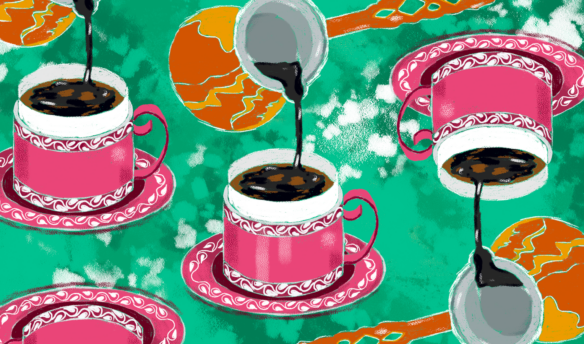More space, that’s what Tim Taylor wanted for his second Ipsento café in Chicago. The original café, a shop he purchased from a church that had inherited it from a parishioner, was defined, at least in its flow, by bottlenecks. The staff bottlenecked in the cramped bar. The customers bottlenecked at the milk-and-sugar station, and then bottlenecked on their way to the door. Taylor and his staff did what they could to streamline things, but it was a small café with a big clientele. There was only so much to be done.
Taylor wouldn’t let that be the problem when he looked for a location for his second café.
“I made sure we had a location with enough space to do what I wanted to do,” he says.
Ipsento 606, named after a nearby park built on a repurposed elevated train track, has room, but it doesn’t feel airy, or like it has more room than it knows how to use. Taylor knows exactly how he wants to use his space, and he wants to use it in many ways.
Customers entering the café first pass by a pour-over bar that includes a single-group Modbar that produces a restricted menu of single-origin espresso drinks. “The slow-bar approach is not sustainable by itself, but it’s something I still want to have because there is a growing interest,” Taylor says. Most customers will not get a drink from here, instead walking to the far end of the bar where they can order drip coffee and a wider range of espresso and milk drinks. Even so, Taylor says, “We want them to see the craft.”
As unusual as that setup is, even odder at first glance is the seemingly unused front section of the bar. With the espresso machines and batch brewers on the back counter, what’s the front counter for except seating? It’s a pair of cocktail bars with a row of ten beer taps between them, which extends service into the evening.
There’s space behind the bar, space for customers coming, going, and staying. Most surprising of all, there’s space below, way below, down in the basement where lines connect the beer, milk, and even garbage cans to the bar. When you had to learn to make do in cramped quarters, you know how to use space when you get it.
A Breakdown of Ipsento’s Coffee Gear and Bar Workflows

1) Three Taps: The self-serve water station includes cold still water, room-temperature still water, and sparkling water. The water, like all Ipsento’s consumed water, goes through an RO system.
2) Sliding Identity: These cabinet doors slide to reveal cocktail accoutrements when bar service shifts to adult beverages in the afternoon.
3) Three For Slow: Baratza Forte grinders serve the slow bar’s rotating pour-over menu. The kettles are Diguo variable temperature goosenecks.
4) Tea Time: Two Bunn H5X hot water towers power the tea program and fill the pour-over kettles.
5) Dual Nitro: A rotating single-origin and the Cascade blend are on nitro lines that connect to kegs in the basement.
6) Espresso Peninsula: Two Slayer two-groups stand back-to-back at the center of the bar. Each is served by a Mahlkönig Peak with Ipsento’s Cascade blend, and one also has a decaf grinder. Both also have warm honey dispensers along with vanilla and cardamom-rose syrup.
7) Single Group: The pour-over bar includes a Modbar grouphead and Peak grinder hopped up with a single-origin coffee. Customers headed to order pass this station first.
8) Batch Brew: An EK 43 grinds beans for the Fetco 2152-XTS double brewer. Another Bunn water tower is for americanos.
9) Milk Taps: Each Slayer has four milk taps that dispense whole, skim, coconut, and a whole-coconut blend (for their Ipsento latte). “The milk on tap has in some ways been awesome, and in some ways a lot of work,” says owner Tim Taylor.
10) Donut Kitchen: In the small kitchen, mini-donuts are made from flour milled in the basement.
11) Farside POS: The point-of-sale sits at the far end of the bar with a pastry display case.
12) Beer: Ten taps fill out the center of the bar, with their lines running to the basement to join the cold-brew and milk in a fridge.
13) Cocktail Wings: The two wings of the central bar are for cocktail service that starts at 4 p.m.















